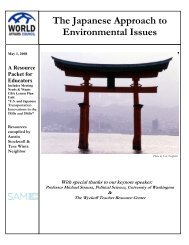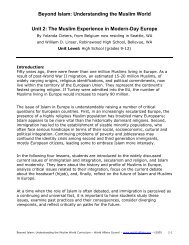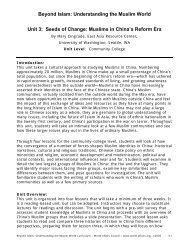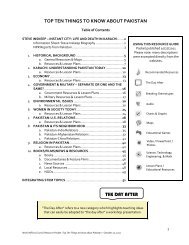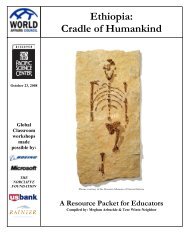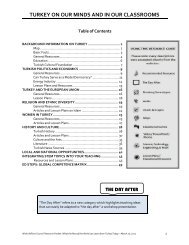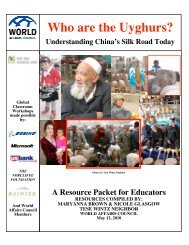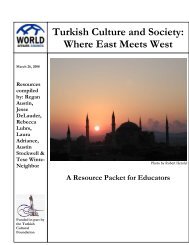If King Tut Could Talk - World Affairs Council
If King Tut Could Talk - World Affairs Council
If King Tut Could Talk - World Affairs Council
- No tags were found...
Create successful ePaper yourself
Turn your PDF publications into a flip-book with our unique Google optimized e-Paper software.
Writing and the ArtsSUITABLE FOR GRADES 6-12Learning Ancient Egyptianhttp://www.rostau.org.uk/aegyptian-l/learning/learning.htmlWelcome to the AEL web site! The AEL discussion list came into existence on February 6th 1997 andprovides a dedicated forum for the discussion of the ancient Egyptian language(s) and texts.Learn All About Reading Hieroglyphicshttp://www.virtual-egypt.com/newhtml/hieroglyphics/So you want to write like an Egyptian, huh? Well it took several years foraspiring scribes to learn how to do it, so for the sake of time we'll just coverthe basics.This site provides a comparison ofEnglish and Egyptian phonetics.This might be challenging forEnglish Language Learners.NYT Learning Network: Write like an Egyptian (04/2002)http://learning.blogs.nytimes.com/2002/04/16/write-like-an-egyptian/In this lesson, students learn about the discovery and import of the Scorpion Tableau. They then researchother examples of ancient writing systems and synthesize their knowledge of them by designing newwriting systems based on these early models.NYT Learning Network: Traders of the Lost Art (09/1999)http://learning.blogs.nytimes.com/1999/09/17/traders-of-the-lost-art/In this lesson, students work in small groups to investigate a variety of art and architecture formscommon during the Old <strong>King</strong>dom epoch in ancient Egypt to evaluate how these forms of art reflect thisculture’s beliefs and values. Groups research their assigned art forms, create an accurate model of theform, and create a visual display of examples of this type of art or architecture from ancient Egypt.BBC: Rosetta Stonehttp://www.bbc.co.uk/schools/primaryhistory/worldhistory/rosetta_stone/teachers_resources.shtmlVisit this site developed by the BBC for lesson plans, handouts, video, photos, and other media related tothe Rosetta Stone and analyzing artifacts. Can be linked with Ramses II lesson below.BBC: Statue of Ramses IIhttp://www.bbc.co.uk/schools/primaryhistory/worldhistory/ramesses/teachers_resources.shtmlVisit this site developed by the BBC for lesson plans, handouts, video, photos, and other media related tothe statue of Ramses II and analyzing artifacts. Can be linked with Rosetta Stone lesson above.University of Michigan: Music in Ancient Egypthttp://www.umich.edu/~kelseydb/Exhibits/MIRE/Introduction/AncientEgypt/AncientEgypt.htmlAlthough music existed in prehistoric Egypt, the evidence for it becomes secure only in the historical (or"dynastic" or "pharaonic") period—after 3100 BCE.Panhistoria: Music and Dancehttp://panhistoria.com/www/AncientEgyptianVirtualTemple/music.htmlThe first great culture to infuse its entire society with the magic of music and dance was that of ancientEgypt. The ancient Egyptians enjoyed life to its fullest and no celebration in ancient Egypt would havebeen complete without music and dancing.Origins of Oriental Dance: Ancient Egypthttp://www.bdancer.com/history/BDhist2b.htmlPeople from every social class were exposed to music and dancing. The laborers worked in rhythmicmotion to the sounds of songs and percussion, and street dancers entertained passersby.<strong>World</strong> <strong>Affairs</strong> <strong>Council</strong> Resource Packet: Pacific Science Center Presents—The Golden <strong>King</strong> and the Great Pharaoh: November 1, 201213



